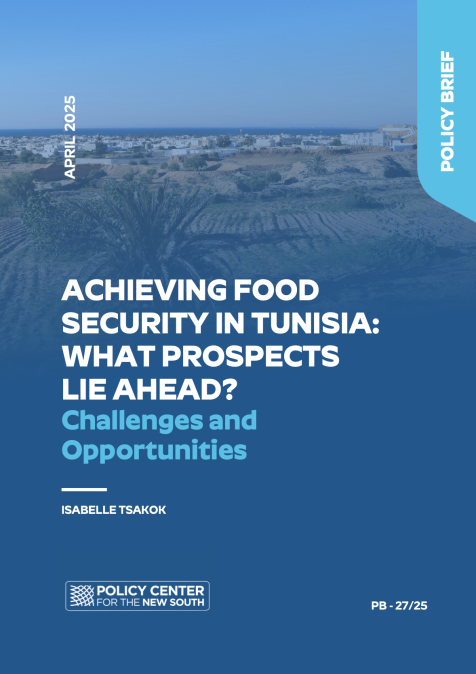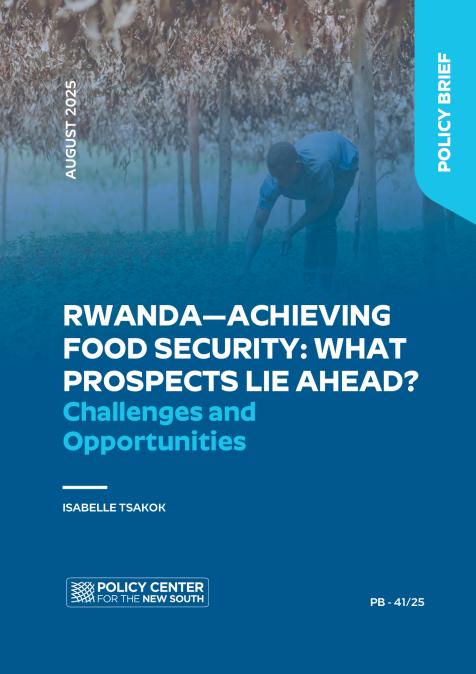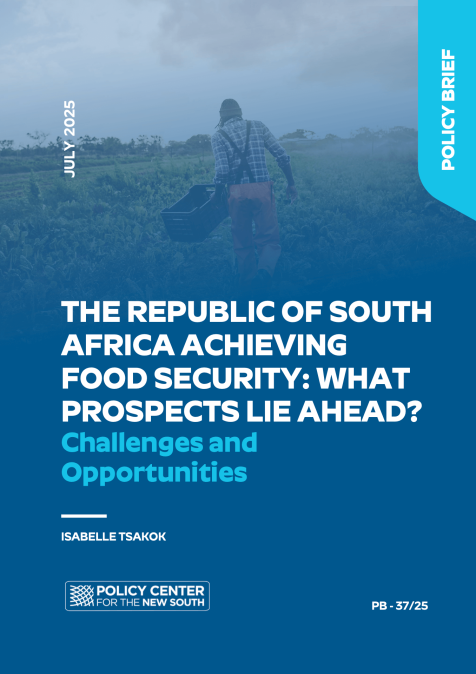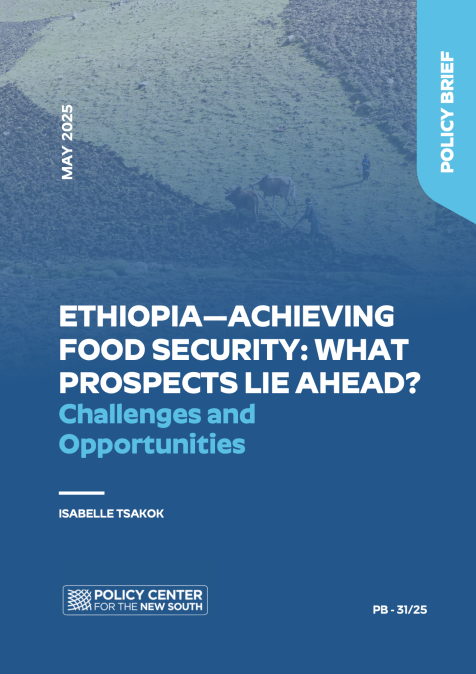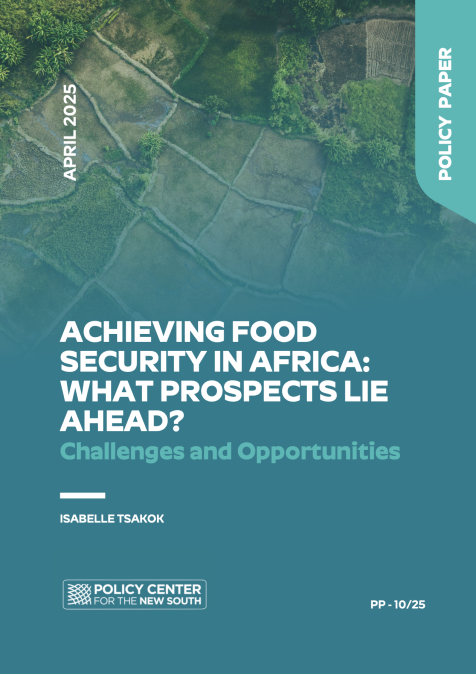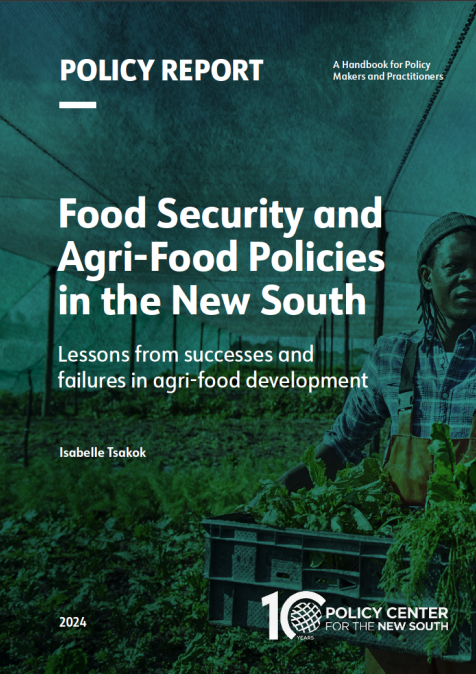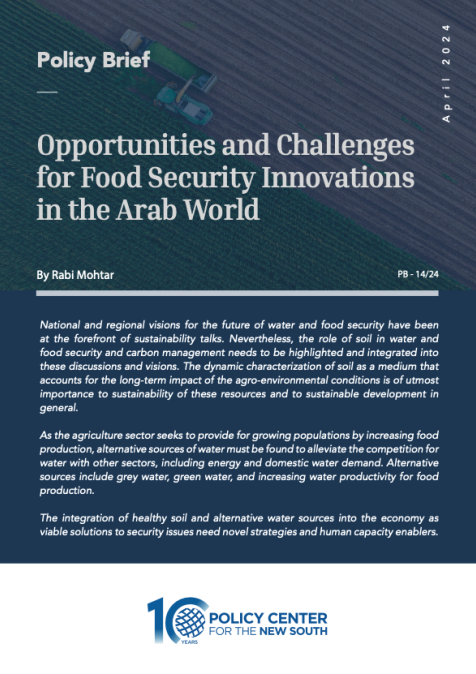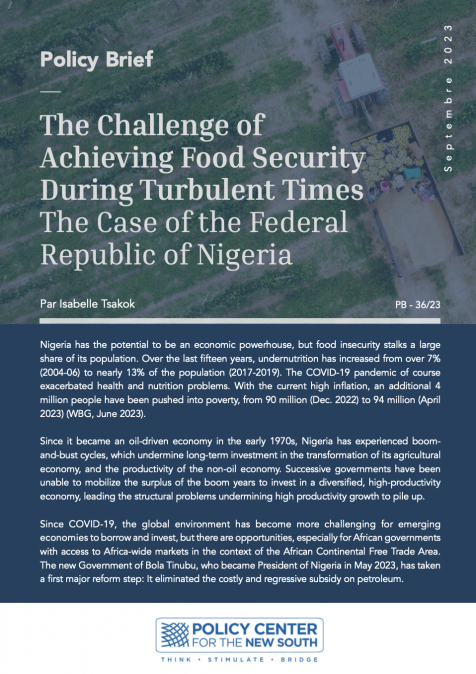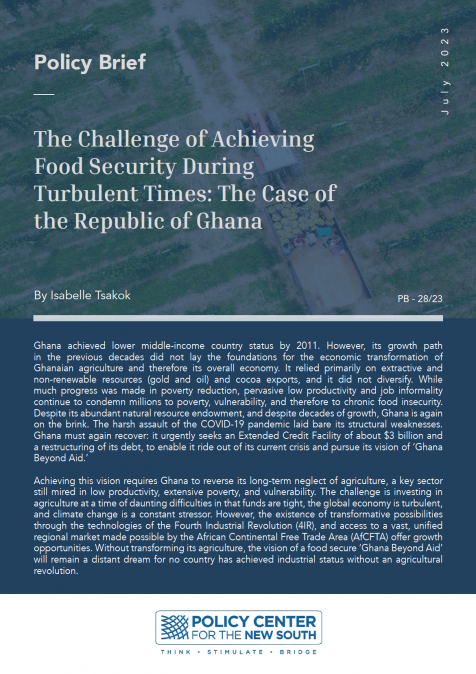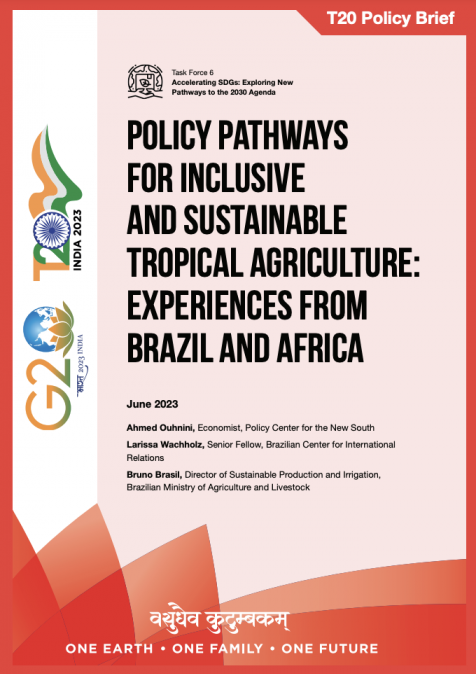Publications /
Policy Brief
Tunisia’s stagnant growth since the Jasmine Revolution (2011) illustrates that political democracy, when not anchored in economic democracy, is fragile at best. Economic democracy remains absent in Tunisia, as markets are concentrated and continue to be burdened by high barriers to entry and rules that favor a privileged few. These conditions stifle dynamism, competition, and ultimately, inclusive growth.
The government’s decision to paper over these structural weaknesses through subsidies and other forms of social welfare, in an effort to maintain social peace, has proven costly and short-sighted.
Under the ongoing threat of climate change, business-as- usual economic management is no longer a viable option. Droughts and floods are becoming more frequent and more destructive; sea-level rise is increasingly contaminating coastal aquifers with saltwater intrusions; and agricultural losses in key crops and livestock continue to undermine food security (FS) for millions.
Tunisia’s leadership can turn this crisis into an opportunity— provided it succeeds in transforming the economy to meet the democratic aspirations of its people, both political and economic. This transformation must also ensure climate resilience, attract private investment (both domestic and foreign), and generate full employment.
Introduction: Scope and Organization
Tunisia is going through difficult times.[1] Since Mohamed Bouazizi[2]—a twenty-six-year-old vegetable vendor—immolated himself in Sidi Bouzid in December, in a dramatic protest against the dismissive treatment of local authorities, the country has been grappling with deep-seated economic challenges. These include widespread unemployment, particularly among educated youth and women; a business environment that undermines competition, productivity, and economic growth; and rampant corruption within an inefficient government administration. These and other factors continue to hinder high productivity, inclusive growth, and, ultimately, FS.
One overarching factor that impacts every aspect of Tunisia’s development—now and in the future—is increasing water scarcity. Tunisia is already a water-scarce country, with renewable water resources amounting to just 399m3 per person per year (World Bank Group, May 2023), well below the absolute water scarcity threshold.[3] This is the most significant constraint shaping what any sector—particularly agriculture—can or should do.
This Policy Brief first takes stock of the poverty and vulnerability situation in Tunisia—its distribution across rural and urban areas, its regional disparities, its evolution over recent decades, and its primary causes among vulnerable groups.
Section II clarifies the concept of FS and explains why it is fundamentally different from food self-sufficiency, a widely pursued national goal in North Africa.
Section III examines the productivity and performance of Tunisia’s agriculture sector—an area increasingly threatened by climate change. However, agriculture is not the only sector relevant to FS. FS is not just about current food consumption, but also about the reliability of access to food in the future. Ensuring this reliability depends on a broader set of factors, including employment and income, health, and an effective social safety net.
In these uncertain times, Tunisia faces numerous challenges and an unclear path forward. Its ability to improve future prospects will depend largely on the leadership’s capacity to address these challenges head-on—by mobilizing the financial and political support needed to fully implement structural reforms.
Section I: Poverty, Inequality and Economic Vulnerability in Tunisia
Progress in reducing poverty until 2019 reversed since the Covid-19 pandemic: Tunisia’s official poverty rate declined from 20.5% in 2010 to 13.8% in 2019. However, this progress was reversed in the wake of the Covid-19 pandemic, with poverty rising to 16.6% in 2021. With a total population of around 12 million, nearly 2 million Tunisians are officially classified as poor.
Significant disparities in poverty exist—between rural and urban areas, within each of these zones, across socio-economic groups, and among regions. Rural poverty stands at 24.8%, nearly double the urban rate of 12.7%. Not surprisingly, rural-urban migration¾driven by limited opportunities in rural areas, or “push” migration¾continues to dominate.
Regional poverty levels are also stark:
- Center-West: (37%)
- North-West: (22.5%)
- Grand Tunis (coastal): (4.7%)
- North-East: (15.2%)
- Center-East: (13.2%)
(Source: World Bank Group, May 2023)
Inequality has also worsened slightly. The Gini index rose from 32.8 in 2015 to 33.7 in 2021 (World Bank, October 2024).
The structural causes of economic vulnerability: Economic vulnerability in Tunisia is deeply rooted in persistently weak and uneven growth, which has left large segments of the population behind. Average annual GDP growth dropped from 3.5% (2000-11) to just 1.7% between 2011 and 2019. This sluggish performance is largely attributable to a policy focus on short-term social assistance—such as cash transfers and public employment—at the expense of structural economic reform.
Private investment has also declined, falling from an average of 17.4% of GDP (2000-10) to 14.9% (2011-19) (World Bank Group, May 2023). In this context of low growth, economic vulnerability is spreading with approximately 24% of the population is at risk of falling back into poverty. This risk is especially high in rural areas, where 42 % of residents were considered vulnerable in 2019, compared to 15 % in urban areas.
Women face particular vulnerability. Their unemployment rate is twice that of men, even though their labor force participation rate was just 26.5 % in 2017. Structural barriers—including restrictive social norms and the lack of public services such as affordable childcare—further constrain their economic engagement.
Another vulnerable group is youth with tertiary education. Despite their qualifications, many face high unemployment due to a mismatch between their skills and available job opportunities (World Bank Group, 2022).
In rural areas, vulnerability is highest among young men with limited education who are employed in low-productivity, low-wage sectors such as agriculture and construction.
Section II: Food Security—Still a Dream for Millions in Tunisia and Why the Concept Matters
FS, a universal goal at both individual and national levels: Everyone—individuals and nations alike—strives to be food secure. At the individual level, FS means having consistent access to sufficient, nutritious food in all circumstances—never having to worry about going hungry. At the national level, governments are concerned that a lack of access to basic staples can trigger social unrest, posing a risk to national security.
In North Africa and elsewhere, many governments equate FS with food self-sufficiency or food sovereignty, but these concepts differ significantly from the broader notion of FS. Specifically:
- Food Self-Sufficiency (FSS) refers to a country’s ability to produce all the food it consumes—particularly staple foods—without relying on imports. Ideally, such a country would not import any staple foods.
- Food Sovereignty (FSY) is defined as “the rights of peoples to healthy and culturally appropriate food produced through ecologically sound and sustainable methods, and their right to defend their own food and agriculture systems. It puts the aspirations and needs of those who produce, distribute and consume food at the heart of food systems and policies, rather than the demands of markets and corporations” (Declaration of Nyéléni, 2007).
In contrast to FSS and FSY, the FAO’s holistic concept of FS is defined as:
- “A situation that exists when all people, at all times, have physical, social and economic access to sufficient, safe and nutritious food that meets their dietary needs and food preferences for an active and healthy life.”
This concept is also referred to as Food and Nutrition Security (FNS). It is a multidimensional concept that requires the simultaneous fulfillment of four key dimensions:
1- Availability – Ensuring a sufficient food supply.
2- Access – Guaranteeing purchasing power for consumers.
3- Utilization – Providing nutritionally adequate food.
4- Stability – Maintaining stable and affordable food prices over time.
These different concepts lead to different policy approaches and real-world consequences. Hence, the concept a country adopts matters. To begin with, FSS and FSY say little about the adequacy of access, utilization, or stability. They are political-economic concepts with broad nationalistic appeal, often requiring trade protectionism regardless of financial, economic, or environmental costs. Furthermore, FSY is characterized by a distrust of foreign multinational corporations.
Moreover, FSS and FSY focus solely on how food is obtained, without addressing its adequacy¾unlike FSH, which does not prescribe how to achieve FS. In our fragmented and turbulent world, skepticism toward certain channels of foreign trade may be warranted, but blanket distrust of all foreign trade is misguided and potentially very costly.
FSS and FSY are blunt policy tools that cannot meet the challenge of promoting the multidimensional nature of FSH, which requires (i) both short- and long-term strategies; (ii) quantitative and qualitative improvements; and (iii) the recognition that food is both a private and a public good.
Once a proponent of FSS, Tunisia now espouses FSY: Despite having supported FSS in previous decades, Tunisia is far from achieving it, as more than 50% of the food consumed domestically is imported. According to Valente (2024), NGOs, civil society, and government officials now consider FSY a high priority, aiming “…to protect against foreign investments that may steal land from local farmers.” Valente cites Aymen Amayed, a researcher at the Arab Reform Initiative, agronomist and political activist, who noted that Tunisia is producing “too much food for exports,” such as olive oil, dates, and strawberries.
Proponents of FSY argue that “food sovereignty is fundamental to end the circle of a new ‘colonial economy’ that still ties Tunisia not only to France, its historical colonial power, but to every European country.” Their goal is to promote domestic production as both a defense against foreign exploitation and a path to independence¾from former colonizers and multi-national corporations alike. They acknowledge, however, that achieving food sovereignty will be a long-term process.
A nation’s desire to assert political independence is entirely understandable, especially for countries with a colonial past. Yet, in today’s interdependent world¾where global trade has been a powerful engine of growth and development¾the challenge lies in how to assert national sovereignty while still strengthening the economy in a way that benefits the entire population. This task is far more complex than simply producing all food domestically.
How long will it take Tunisia to achieve FSY in cereals? It will likely take many years, given the substantial share of imports in current consumption. Since the 2020s, domestic cereal production has accounted for only 31.6% of total consumption on average¾covering about 60% of durum wheat and a mere 3.6% of soft wheat (World Bank Group, May 2023). In other words, well over 50% of cereals are imported.
This raises an important policy question: during this extended transition period, what is the best course of action for Tunisia? Should the country focus on increasing the production of cereals and other staple foods to achieve FSY, or should it instead pursue a more sustainable, productive, diversified, resilient, and inclusive model of agricultural and economic growth¾one that not only increases the supply of staple and non-staple foods but also generates higher incomes and more employment opportunities?
For Tunisia’s more than 2 million poor and vulnerable citizens, which development pathway would offer greater FS and long-term well-being?
Section III: Tunisian Agriculture and Agro-Industry under the Threat of Climate Change
Characteristics of Tunisian agriculture and agro-industry[4]in the 21st century: Tunisia’s geographical position—bordered to the north and east by the Mediterranean Sea and to the south by the Sahara Desert¾exposes it to diverse bioclimatic zones. The northern coastal belt is relatively humid, while the northern and central regions, where most agricultural activities occur, experience hot, dry summers and cool, moist winters. These seasonal variations largely determine the agricultural growing period.
Tunisia can be broadly divided into three climatic zones:
1- The Northern Mediterranean region
2- The central steppe region
3- The southern desert region.
Successive Tunisian governments have invested substantially[5] in irrigation infrastructure. Irrigation mobilizes 92 % of the country’s renewable water resources, directing them to areas of greatest agricultural need. Agriculture accounts for approximately 80% of total water use. The agricultural sector encompasses annual crops, tree crops, livestock, fisheries, and agro-industry.[6] It remains a vital part of the national economy, contributing around 10% of GDP, 10-12 % of exports, and 15%-20% of total employment. However, its actual contribution varies significantly from year to year depending on rainfall¾its timing, quantity and distribution.
An arid to semi-arid climate covers roughly 80% of Tunisia. Over 90% of agricultural production is rainfed, representing 65% of the sector’s value added (Yilmaz et al., 2023). Irrigated agriculture[7] contributes up to 35% of agricultural value added (World Bank Group, November 2023).
The sector is strongly dualistic in structure. A majority of farms are small-scale: 54% of holdings are less than 5 hectares each. In contrast, just 1% of holdings account for 22% of the utilized agricultural area (UAA), based on 2004-2005 data. A major structural issue affecting the sector is the widespread lack of formal land titles and tenure insecurity. These challenges undermine land productivity and constrain the development of a dynamic land market (Schwoob et al., January 2019).
Main crops include cereals such as wheat and barley; tree crops like citrus fruits, dates, almonds, pistachios, and olives; as well as forage, vegetables (including high-value horticulture), and legumes. Other cultivated products include cotton and sugar. Livestock rearing¾dairy and other cattle, sheep, and goats¾is also significant, alongside fisheries and aquaculture. Agro-industries linked to this production include leather, textiles, olive oil, dates and fish.
However, agricultural production is being severely curtailed and continues to face mounting threats from several climate-related challenges:
- Variable rainfall and rising temperatures: Drought is not new to North Africa; it is a recurrent phenomenon. However, climate change is expected to increase both its frequency and severity. Since 1990, Tunisia has experienced drought in ten separate years: 1994, 1995, 1997, 2000, 2001, 2002, 2008, 2010, 2013, and 2016. The most severe drought in 50 years spanned three consecutive years, from 2000 to 2002 (Dorte et al., October 2018). Additionally, the decade from 2010 to 2020 was the warmest in the past 62 years (Mohamed et al., September 2023). Rainfall is highly variable, averaging only 220 mm per year, with extremes ranging from just 20 mm in Borma (southwest) to 880 mm in Tbarka (northwest).[8]
- Rising sea levels and salt-water intrusion: Rising sea levels are increasing coastal erosion and causing saline contamination of coastal aquifers, many of which are used for irrigation. As a result, salinization has led to the degradation¾and in some cases, complete loss¾of agricultural land, forcing farmers to abandon their farms. Irrigation with saline water has sterilized significant portions of Tunisian soil. Indeed, in Tunisia, irrigation is the primary cause of salinization in irrigated areas. Projections suggest sea levels will rise by 30-50 cm under future climate change scenarios (Mohamed et al., September 2023).
Vulnerability of key agricultural products to climate change—cases of wheat, dairy, dates and olives: Each of these agricultural products plays a crucial role in both local economies and the national economy, contributing significantly to income, employment and food security along the entire production-marketing-processing-food chain. Approximately 84% of wheat farmers identify lack of rain as a major constraint. Additionally, some 20% report insufficient irrigation water, while another 20% cite salinity in irrigation canals as a growing problem, contributing to declining yields. Dairy cows suffer from increasing heat stress during the extended summer months (mid-May to mid-September). The heat reduces both the availability and nutritional quality of forage and feed, leading to lower milk yields and diminished milk quality. Consequently, milk and cheese processors also report concerns over the declining quality of their input materials (Dorte et al., 2018).
Dates are primarily cultivated in the oases of southern Tunisia, areas increasingly threatened by groundwater depletion, rising salinity in irrigation canals, and rising temperatures. These conditions foster the spread of diseases and reduce yields and fruit quality (Abdelaziz et al., December 2021). Date palms are especially vulnerable due to their high-water requirements.[9] The renowned Deglet Nour variety¾often referred to as the “Queen of the Dates” and highly prized in export markets¾requires approximately 20,000 m3 of water per hectare. Amid growing water scarcity and the expansion of Deglet Nour monocultures, the sustainability of other date varieties is increasingly at risk (Addezio, August 2024).[10]
Olives are omnipresent in Tunisia, covering approximately 1.3 million hectares (Putinja, June 2024).[11] Found both in the rolling hills of the northwest and the arid south, olive trees are traditionally drought-resistant and well adapted to the Mediterranean climate. Nevertheless, rising temperatures and growing water scarcity are taking a toll. Older trees are especially vulnerable (Gargouri et al., 2003). In the absence of technological innovation in cultivation and processing, climate change is expected to impact both the quality and quantity of olive oil. Challenges include increasing temperatures and water scarcity, as well as rising Greenhouse Gas (GHG) emissions and the reduction of essential chill hours (300 to 600) necessary for vernalization.[12] Alarmingly, projections suggest that by the end of the 21st century, Tunisia could lose up to 70% of its olive oil production compared to the 1981-2010 average (Dawson, May 2022).
Section IV: Challenges and Opportunities
Challenges are multiple, interlinked and existential: Tunisia is in crisis¾economically, financially, environmentally. The country’s response to persistent slow growth, low productivity, and high unemployment (at 16%) since the Jasmine Revolution[13] has increased its financial fragility. Reliance on subsidies (e.g., for energy and food) and the social safety net to maintain social stability has raised public debt from 40.7% in 2010 to 79.9% in 2021 (World Bank Group, 2023). At the same time, the government has allowed the root causes of a poorly performing economy to persist. These include: (i) market concentration, with high barriers to entry, preventing a level playing field for fair competition; (ii) disincentivizing rules on investment, trade and licenses; and (iii) poor access to finance, especially for SMEs.
To this already challenging economic environment, add cumbersome and often corrupt bureaucracies responsible for implementing these rules. The Covid-19 onslaught¾soon followed by supply chain disruptions and inflation triggered by the Russian invasion of Ukraine in February 2022¾further hit Tunisia’s economy. On top of all this, the extreme effects of climate change only worsen an already dire situation. Today, increasing water scarcity¾critical in an already water-scarce country¾threatens the very basis of livelihoods in urban and rural areas.
Turning crisis into opportunity – rebuilding a climate-resilient, high-productivity, inclusive, and food-secure Tunisia: This period of crisis can also serve as an inflection point for Tunisia’s development¾if the government effectively addresses the existential challenge of climate change. Increasing water scarcity, combined with extreme weather events, poses the most fundamental threat to Tunisia’s development. In a climate-changed world, water is the new gold—adequate, dependable, and affordable water is essential.
To rise to this challenge, Tunisia must invest in and fully implement its National Strategy for Ecological Transition (SNTE, 2023/35/50). The objective of the SNTE is to build a resilient, sustainable, socially just, and inclusive development model. This requires transformative changes in how Tunisians consume, produce, work, and live, while simultaneously promoting conservation and striving for carbon neutrality.
In other words, the SNTE envisions fundamental shifts in the functioning of the economy and in daily life. These include:
- Effective water management is essential: Tunisia cannot continue to focus solely on water mobilization investments to meet supply and demand needs. It must urgently address water losses, which increased from 25% in 2010 to 34% in 2021 for SONEDE (National Water Works and Distribution Company). In rural areas, losses are even higher¾around 50%. Water tariffs are too low: the price of irrigation water from public schemes has remained unchanged since 2004 and covers only 18% of the cost of delivering that water (World Bank Group, Nov 2023).
- But effective water management is not sufficient: Non-conventional sources of water must be mobilized to meet growing demand due to population and urban expansion. This means expanding wastewater treatment and sea water desalination. However, the burden of these investments cannot fall solely on the state. Currently, the tariff charged by the Office National de l’Assainissement (ONAS, National Sanitation Office) for treated wastewater is too low to cover network maintenance and additional treatment. As a result, wastewater quality is poor¾only about 2% of Tunisia’s irrigated land can be directly irrigated with treated wastewater. The financial performance of state-owned enterprises (SOEs) has been weak, with insufficient tariff increases undermining their operations. For instance, in 2018, the state covered 82% of all water-related costs, from mobilization in dams to sanitation and reuse.
- Addressing the existential threat of climate change to agriculture and coastal areas: Solving the water crisis is central to tackling climate change’s impact on agriculture and coastal areas. According to Tunisia’s Water 2050 Strategy, combining wastewater reuse with desalination could boost water supply by 693 million cubic meters. But further action is needed. Farmers and livestock keepers require support to adopt climate-smart practices such as no-till cultivation, cover cropping, and more efficient water use. Agro-forestry should also be promoted as a sustainable land-use system that can mitigate climate impacts, enhance soil fertility, and increase agricultural productivity.
Decarbonizing the energy sector is essential: This is critical not only to alleviate the water crisis but also to reduce greenhouse gas emissions across other sectors, such as industry, transport, and construction. Decarbonization requires an economy-wide shift from natural gas to renewable energy, with wind and solar offering the least-cost solutions for electricity generation. In short, nothing less than a complete remaking of Tunisia’s productive structure is required.
The high costs of an economy-wide energy transition are outweighed by the even greater costs of a business-as-usual (BAU) approach: The estimated investment and operational costs through 2050 amount to USD 25,048 million. However, the cost of inaction is likely to be far higher. Under the worst-case scenario—where Tunisia takes no urgent action—GDP could shrink by 3.4% by 2030. Value added in agriculture could fall by 15% by 2030 and by as much as 50% by 2050, while the poverty rate could rise to 21.3% by 2030. Such sharp declines would be socially destabilizing, potentially triggering an increase in climate change refugees.
Already, an estimated 566,000 Tunisians emigrated between July 2020 and March 2021 (World Bank Group, May 2023). Rural-to-urban migration, particularly from southern Tunisia, has become a pronounced trend (Chibani, February 2022).[14] Moreover, Tunisia is already a preferred route for international migrants from Sub-Saharan Africa and even parts of Asia seeking to reach Europe (Ismail et al., April 2025).[15]
A repurposing of public expenditures, smarter subsidies, private investment, and access to concessional funding is urgently needed: Faced with compounding challenges, Tunisia must seize this moment to transform crisis into opportunity. A key step is to repurpose its expenditures. However, repurposing alone offers, at best, a short-term palliative. Much more is required. Tunisia’s financial needs are substantial— estimated at 13% of GDP by 2027. Between 2023 and 2027, an estimated USD 48.9 billion (in current prices) will be needed (World Bank Group, May 2023).
There is no alternative: Tunisia must implement deep financial reforms and create a more conducive economic environment to attract greater private investment, both domestic and foreign.
Building inclusive institutions, investing in human capital, and ensuring good governance are key to a more resilient, productive and prosperous Tunisia: In its 2011 revolution, Tunisia distinguished itself by its powerful demand for a transformative re-structuring of political power. Today, it must complement that achievement by insisting on economic democracy—an economy rooted in competitive market systems that generate opportunities for all, not just for a privileged and well-connected privileged minority.
Tunisia must invest in inclusive institutions and human capital to breathe life into its economy. As Acemoglu and Robinson (2012) put it: “Inclusive economic institutions foster economic activity, productivity growth and economic prosperity… Nations fail when they have extractive economic institutions, supported by extractive political institutions that impede and even block economic growth.”
Conclusion: What Prospects Lie Ahead?
At this “critical juncture”[16] in Tunisia’s development, the prospects for achieving food security for all hinge on the leadership’s capacity to transform crisis into opportunity—by confronting climate change and charting a course toward a resilient, productive, and inclusive economy.
Tunisia can leverage one of its most powerful assets—citizen engagement—to enhance both local and national governance. This can serve as the first step in the long journey toward the socio-economic transformation the country urgently needs.
Bibliography
Abdelaziz, Fatma, Mia Ellis, and Xiaobo Zhang. December 2021. “A study of Tunisia’s leather and date sectors.” A report for the Food and Agriculture Organization of the United Nations. Regional Program Working Paper# 36 https://cgspace.cgiar.org/server/api/core/bitstreams/fdac2906-19d6-4e61-bf68-b430a8471da3/content
Acemoglu, Daron and James A. Robinson. 2012. Why Nations Fail: The Origins of Power, Prosperity and Poverty. Crown Business: New York.
Addezio, Nadia. Aug. 2024. “’The Queen of Dates’ Threatening Tunisia’s Future”. Fair Planet. https://www.fairplanet.org/story/tunisia-carthage-deglet-nour-date-export-dry-oases/
Chibani, Achref. Feb 28, 2022. “Migrating to Adapt to Climate Change, Tunisians Lose their Way of Life.” Wilson Center’s Middle East Program. https://gbv.wilsoncenter.org/article/migrating-adapt-climate-change-tunisians-lose-their-way-life
Climate Check. “Water Stress, Drought, and Climate Change.” https://climatecheck.com/risks/drought/water-stress-drought-and-climate-change#:~:text=This%20indicator%20measures%20water%20stress,m3%20indicate%20extreme%20water%20scarcity.
Dawson, Daniel. May 07, 2022. “Report: Climate Change Will Dramatically Reduce Tunisian Olive Oil Production.” Olive Oil Times. https://www.oliveoiltimes.com/production/climate-change-will-reduce-tunisian-olive-oil-production/105921
Dorte, Verner, David Tréguer, John Redwood, Jens Christensen, Rachael Mc Donnell, Christine Elbert, and Yasuo Konishi. October 2018.CLIMATE VARIABILITY, DROUGHT, AND DROUGHT MANAGEMENT IN TUNISIA’S AGRICULTURAL SECTOR. World Bank Group. https://documents1.worldbank.org/curated/en/318211538415630621/pdf/130406-WP-P159856-Tunisia-WEB2.pdf
Gargouri, K., A. Rhouma, A. Sahnoun, M. Ghribi, H. Bentaher, B. Ben Rouina and M. Ghrab. 2003. “Assessment of the impact of climate change on olive growing in Tunisia using GIS tools.” Institut de l'Olivier, P.O. Box 1087
Ismail, Zeineb, and Ben Malek, Khadhraoui. 03 April 2025. “Leaked data reveals the extent of Tunisia and the European Union’s cooperation on migration” Inkyfada. https://inkyfada.com/en/2025/04/03/leaks-migration-tunisia-europe/
Mohamed, Mostafa Abd El-Hameed, Fawzia Ibrahim Moursy, Mohammad Hamdy Darrag, Mohamed El-Sayed El-Mahdy. September 2023. “Assessment of Long-term Trends and Mapping of Drought Events in Tunisia.“Scientific American, Vol. 21. https://www.sciencedirect.com/science/article/pii/S2468227623002223
Putinja, Isabel. June 02, 2024. “Tunisia’s Olive Oil Heritage.” The Olive Oil Professor.https://oliveoilprofessor.com/blog/tunisias-olive-oil-heritage
Valente, Giorgia. 05/05/2024. “Experts advocate for Tunisian Food Sovereignty as a Path to Independence”. The Medialine.
Schwoob, Marie-Hélène,Iddri Mohamed Elloumi.January 2019 “RURAL UNDER-DEVELOPMENT AND INTERNAL MIGRATION: the example of Tunisian agriculture” INRA, Tunisia. Ch 8 of book: MediTERRA 2018 (English). file:///Users/isabelletsakok/Downloads/chapter-8-rural-under-development-and-internal-migration-the-example-of-tunisian-agricult
World Bank Group. Sept. 2022. Tunisia Systematic Diagnosis: Rebuilding trust and meeting aspirations for more prosperous and inclusive Tunisia—Executive Summary.xzhttps://openknowledge.worldbank.org/server/api/core/bitstreams/c894a3fe-1283-5bbc-a2ea-70231c116b16/content
World Development Indicators (WDI). Tunisia GNI/per capita. 2003-2023. Atlas method. https://data.worldbank.org/indicator/NY.GNP.PCAP.CD?end=2023&locations=TN&most_recent_value_desc=false&skipRedirection=true&start=2003&view=chart
World Bank Group. May 11, 2023. Country Partnership Framework for the Republic of Tunisia, for the period FY 23-FY 27. Report No. 180304-TN.https://thedocs.worldbank.org/en/doc/6e14e6c4eca4443847a348627c6586e7-0280012023/original/230510-Tunisia-CPF-New-Board-Stage.pdf
World Bank Group (World Bank Group). November 2023. Tunisia: Country Climate and Development Report.https://openknowledge.worldbank.org/server/api/core/bitstreams/fb44f7bf-242f-43fb-9c9b-d0d78900f290/content
World Bank. October 2024. Tunisia: Poverty and Equity Brief. https://documents1.worldbank.org/curated/en/099717401132525015/pdf/IDU11ca015b610b0d1413b1b10e102e385891c41.pdf
World Bank. Fall 2024. Tunisia: Economic Monitor –Equity and Efficiency of Tunisia Tax System https://documents1.worldbank.org/curated/en/099450111122440099/pdf/IDU-4a597e6d-2db7-44c5-bdb6-c083b0765c27.pdf
Yilmaz, Devrim, Sawsen Ben-Nasr, Achilles mantes, and Nihed Ben-Khalifa. 2023. “Climate change, Loss of Agricultural Output, and the Macro Economy: The Case of Tunisia.” AFD Research Papers. Cairn Info. Humanities and Social Sciences. https://shs.cairn.info/journal-afd-research-papers-2023-286-page-1?lang=en
[1] The GNI/cap for Tunisia was USD 4,310 (2014) when the new constitution was ratified. Since then, GNI/cap has been decreasing to reach USD 3,720 in the depths of the Covid pandemic in 2020. In 2003, the GNI/cap was USD 2,420; in 2023, the GNI/cap was USD 3, 840 (WDI).
[2] Mohamed Bouazizi was the sole income earner in an extended family of eight. There is some dispute as to what exactly happened. But the overall story is that his produce was confiscated because he did not possess a license. He went to complain to the officials of the local municipality on December 17, 2010, to have his produce returned but he was denied an audience. Within an hour of this added humiliation and defeat, he returned to the headquarters, doused himself with a flammable liquid and set himself on fire. This dramatic self-immolation, and the heavy-handed response of the local police to peaceful protesters, provoked riots the next day in Sidi Bouzid. Bouazizi was transferred to a hospital near Tunis. The President Ben Ali even visited him on December 28. However, Bouazizi died in January 2011. There were many demonstrations in December and January that included other socio-economic groups, e.g., lawyers, teachers, concerning joblessness. In mid-January, Ben Ali dissolved the government, declared a state of emergency, and fled the country, receiving asylum in Saudi Arabia. Demonstrations in the Arab world followed in Spring 2011, which toppled Mubarak, Gaddafi, and Bashar El Assad. There were demonstrations elsewhere too; in Morocco (2011-12), Yemen, Bahrain and Algeria. Ben Ali died in Saudi Arabia on September 19, 2019.
[3] An amount of water below 1700 m3 per person/per year indicates water stress; an amount below 1000m3 to 500 m3 per person/per year indicates extreme water scarcity (Climate Check).
[4] The term agro-industry comprises agri-food and non-food like leather. In this policy brief, the term agriculture includes agrifood and agro-industry. So these latter two terms will not be repeated. The context will make it clear.
[5] Around 35% of agricultural investments in recent decades have been allocated to irrigation infrastructure. Some 410,000 hectares have been equipped, representing 95% of estimated potential (Dorte et al., 2018).
[6] Agro-industry contributes to roughly 15% of manufacturing which contributes to roughly 15.14% of GDP (2023); therefore, agro-industry contributes to roughly 2% of GDP.
[7] Public irrigation schemes from large dams constitute 56% of all irrigable area (World Bank Group, November 2023).
[8] Bormais located in the southwestern region, on the border with Algeria in the Tataouine Governorate in Tunisia; Tabarka is located on the coast, in northwestern Tunisia.
[9] Most of the date production is concentrated in four governorates in south/southwestern Tunisia—Gabes, Gafsa, Kebili, and Tozeur—which together account for 10 percent of the country’s population. Tunisia produces 200 varieties of dates, but the world-renowned Deglet Nour, originally from Algeria, constitutes 80% of total production (2018).
[10] It appears that the Deglet Nour is more vulnerable to attacks from dust mites and Ectomyelois ceratoniae ("carob moth"), which can damage over 20% of its harvest.
[11] An estimated 85% of groves are located in the center of the country around the city of Sfax, as well as in the south (Putinja, June 2024).
[12] Vernalization is the cooling of the seed during germination to accelerate flowering once the seed is planted.
[13] The disturbances lasted from December 17, 2010, to January 14, 2011, leading to the ousting of long-tiime President Zine Ben Ali Abidine Ben Ali, who fled to Saudi Arabia.
[14] By 2050, up to 19 million people in North Africa may be forced to migrate due to the impacts of climate change.
[15] Migrant departures from Tunisia: Sept 2023—97,667; Jan-Sept 2024: 15,835 (Ismail et al., April 2025).
[16] The phrase “critical juncture” is used extensively by Acemoglu and Robinson (2012). They define the term as follows: “Critical junctures are major events that disrupt political and economic balance in one or many societies…” Under the continuing threat of climate change, Tunisia is now fighting for its very survival. It is at a critical juncture.

